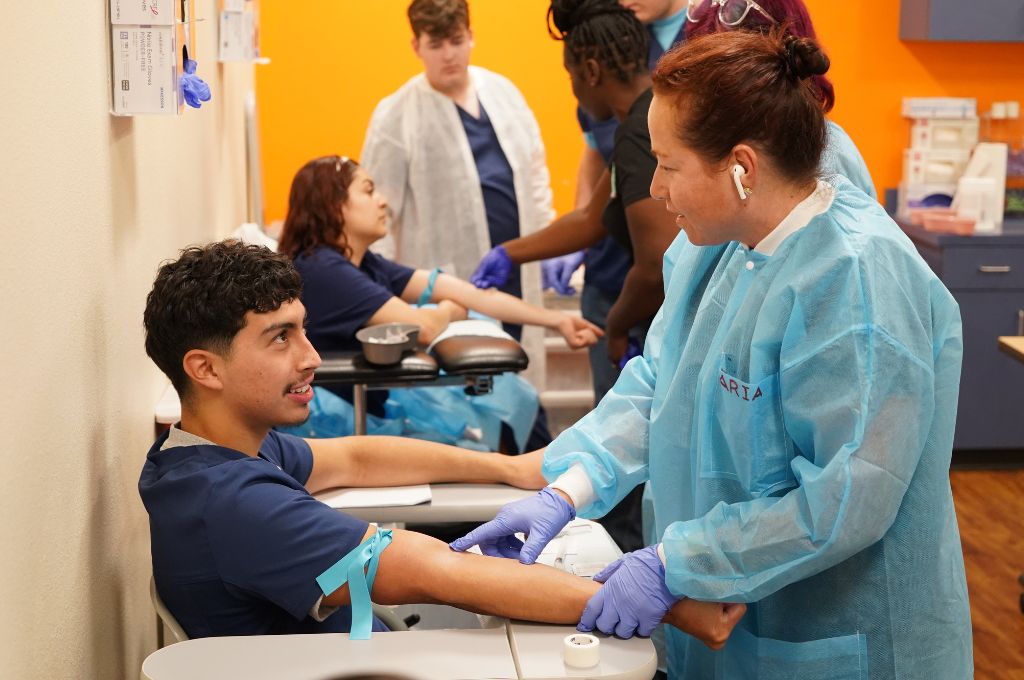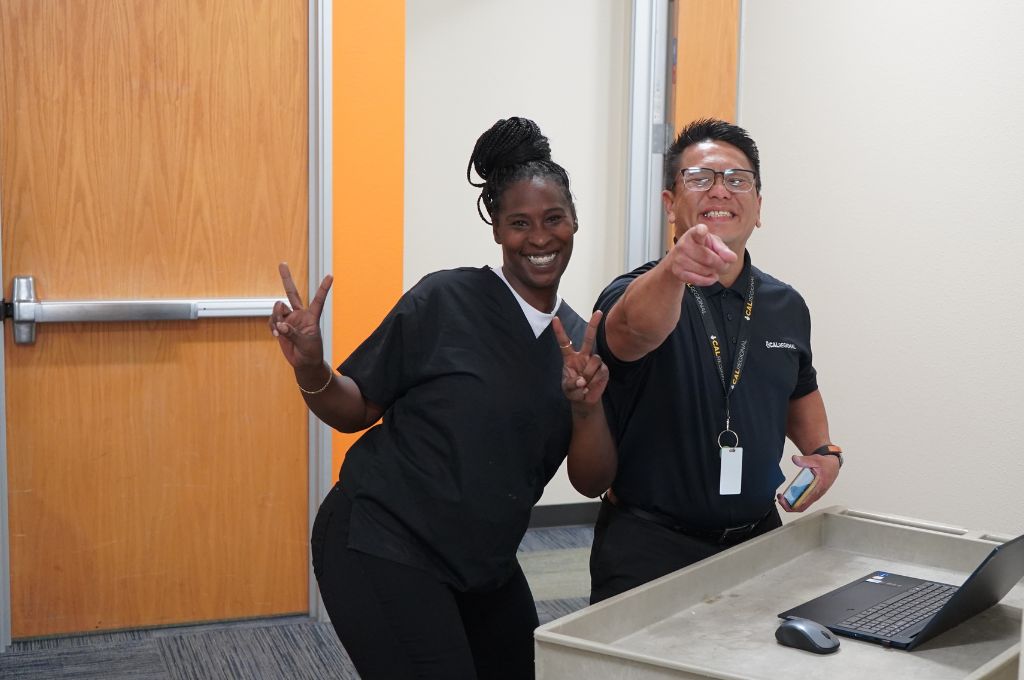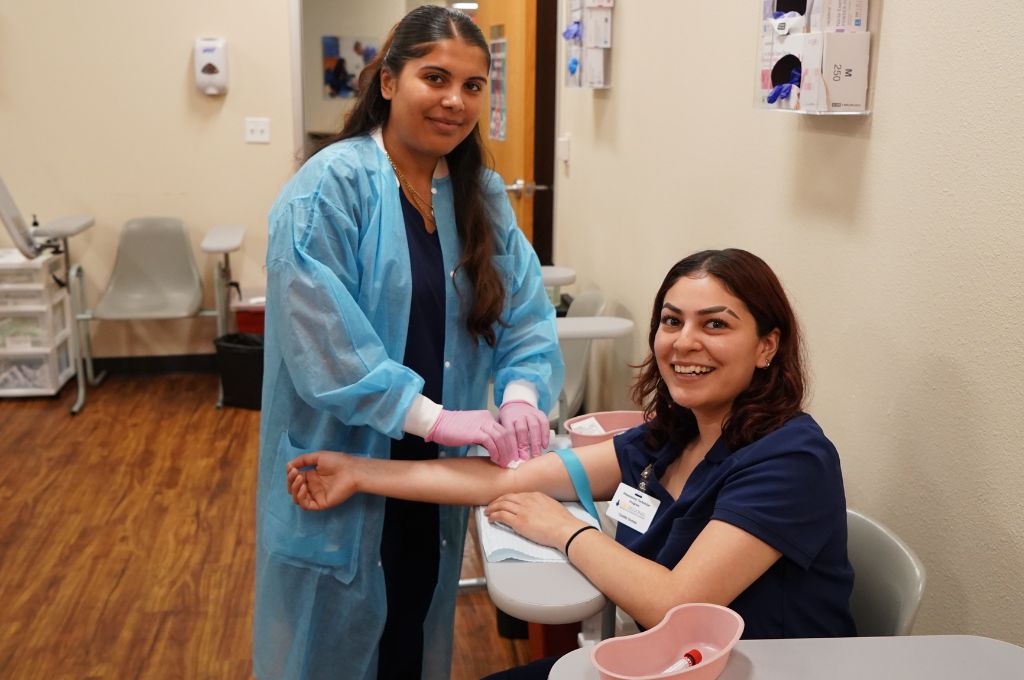Table of Contents
Are you interested in enrolling in a phlebotomy training program? If so, you might know what to expect, but our programs are much more than just drawing blood. As a student, you’ll be learning a procedure called venipuncture to collect blood from patients for testing, transfusions, research, and donations, but that’s just the tip of the syringe!
This blog will guide you through everything you need to know about CALRegional’s phlebotomy training. From learning the basics through lectures to putting your skills to the test in our hands-on lab, you’ll certainly enter the medical field prepared.
We’ll cover what you need to know before you begin the phlebotomy training course and what to expect after graduating and receiving your national CPT (certified phlebotomy technician) certification. Keep reading to get a pulse on what our course has in store for you.
Want To Learn More?
Key Takeaways
- Flexible Training Duration: CALRegional offers phlebotomy training programs ranging from 3-week full-time courses to 12-week part-time or evening classes, accommodating various schedules.
- Comprehensive Curriculum: The program is divided equally between lectures and hands-on labs, covering human anatomy, blood collection techniques, safety protocols, and patient communication skills.
- Hands-On Experience: Students gain practical experience in a controlled environment, practicing blood draw techniques under instructor supervision to build confidence and proficiency.
- Preparation for Certification: The training prepares students for national certification exams, a crucial step toward becoming a certified phlebotomy technician.
What Do You Learn in Phlebotomy Training?
CALRegional phlebotomy training classes equip you with the knowledge and skills to perform blood draws safely and efficiently. The program consists of 50% lectures and 50% labs. This means you will alternate days of lectures with days of hands-on training. All of our phlebotomy classes are 100% in-person.
Lecture: The Basics of Phlebotomy
During the lecture part of your phlebotomy training program, our expert instructors will teach you the fundamentals of being a phlebotomist, various techniques for drawing blood, medical terminology, and what you can expect on a typical work day.
Some of the topics included in CALRegional phlebotomy training lectures include:
- Human anatomy, physiology, and medical terminology with emphasis on the circulatory system
- Proper identification of patient and specimens for accuracy in patient care
- Proper selection and preparation of skin puncture site and antiseptic
- Blood collection equipment and proper order of draw
- Safety protocols, advanced infectious disease control, and biohazards
- And much more!
Drawing blood isn’t for the faint of heart. You’ll also learn how to effectively communicate with your patients to make them feel at ease during the procedure.

Lab: Mastering the Art of Venipuncture
Our phlebotomy training isn’t just learning the difference between veins and arteries or red and white blood cells. It’s time to put your gloves on. The lab is a controlled, hands-on environment where you’ll learn to apply the knowledge learned in the classroom.
During the lab portion of the phlebotomy training program and under the supervision of your instructor, you will perform the following:
- Venipuncture: the puncturing of a vein to withdraw blood
- Butterfly needles: devices used to draw blood
- Evacuated tube systems (ETS): the most common way to collect blood specimens
- Syringe methods of draw: various methods of drawing blood to accommodate specific scenarios and patient needs such as pediatric and geriatric applications.
- Properly handling and labeling samples
- Maintaining a sterile work environment to prevent contamination
The lab is critical for gaining confidence in using phlebotomy equipment such as needles, tourniquets, and collection tubes. You’ll simulate real-world scenarios ranging from routine blood draws to more complex procedures to prepare you for your future career in the healthcare field.
Our phlebotomy training students practice drawing blood on fellow students, volunteers, or patients. CALRegional phlebotomy students get the required number of blood draws per state requirements so that they feel confident in their skills upon exiting the program.
Externship: Real Phlebotomy Technician Experience
If you are a Texas student, you can skip this section because externships are only currently offered through California phlebotomy training programs and are not required by the State of Texas.
California requires clinical externships to obtain state licensure. CALRegional externships are built into the phlebotomy program so that students can get clinical experience quickly and conveniently in a real healthcare setting.
During your externship, you will work under the guidance of experienced phlebotomists and healthcare professionals. Your externship is important for several reasons:
- It allows you to practice your skills in a real-world environment
- You gain exposure to different types of patients and medical conditions
- You learn to work efficiently in a fast-paced clinical setting
- You build professional relationships that can aid in job placement
Externships bridge classroom learning and professional practice, ensuring you are well-prepared for your career. Curious about how externships work? We’re answering the 10 most common questions in this blog.
Want To Learn More?
National Certification Exam: Put Your Phlebotomy Training to the Test
When you complete the CALRegional program, you will be prepared to take the exam for Phlebotomy Technician Certification through the American Medical Certification Association (AMCA). The national exam is taken on-site on the last day of class from a computer. It has 100 questions and an allotted time of two hours. Don’t let test jitters get the best of you; CALRegional phlebotomy students have a 91% exam passing rate.
The certification exam tests your knowledge and skills in areas such as:
- Professionalism and Regulatory Compliance
- Infection Control and Safety
- Patient Identification, Assessment, and Site Preparation
- Equipment Selection and Maintenance
- Collection of Blood and Non-Blood Specimens
- Specimen Processing and Transportation
While certification requirements vary by state, obtaining the national certification enhances your job prospects and credibility. Passing this exam demonstrates your knowledge and commitment to phlebotomy, making you a more attractive candidate to potential employers. This milestone marks your completion of the course; you are officially a certified phlebotomy technician!
A Note on State Licensure
Licensure requirements vary state by state. Texas does not require licensure at the state level. However, for California students, once you pass the exam, you may apply for state licensure CPT1 through the CDPH, Laboratory Field Services.

The Benefits of Becoming a Phlebotomy Training Specialist
Phlebotomy is a rewarding healthcare career in more ways than one.
High Demand for Phlebotomists
The demand for your expertise is on the rise. According to the U.S. Bureau of Labor Statistics, employment of phlebotomists is projected to grow 17% from 2019 to 2029, much faster than the average for all occupations.
Various Work Environments
Phlebotomy training allows you to work in various settings ranging from hospitals, healthcare clinics, laboratories, blood donation centers, and many more. With so many options, you can choose a work environment that best suits your preferences and lifestyle.
Competitive Salary and Room for Growth
CPTs earn competitive salaries, and many employers also offer benefits, including health insurance, PTO, and retirement plans. Phlebotomy training is often the first step towards numerous career paths, such as becoming a medical assistant or registered nurse.
Personal Fulfillment
Additionally, working as a phlebotomist impacts patients’ lives. Your knowledge and expertise in drawing blood play a crucial role in diagnosing and treating medical conditions. Interactions with patients can be gratifying as well. Whether cracking a joke with someone’s grandmother or helping a child overcome their fear of needles, you provide comfort during the blood-drawing process.
Bonus: Make Friends & Have a Mentor for Life
If you take just one look at CALRegional reviews online, you’re bound to see comments from prior students who obtained more than just a certification during their program – they gained memories to last a lifetime.
“Today was the final day of class, and I am not exaggerating when I say that I actually teared up. I didn’t want it to end!” – Valarie R.
FAQ
Phlebotomy training at CALRegional takes 3 to 12 weeks, depending on your schedule. Full-time students can finish in as little as 3 weeks, while part-time or evening classes take up to 12 weeks.
CALRegional’s CPT program costs $2,995 or less. This fee includes tuition, the national exam, and CPR certification.
Some of CALRegional’s partner schools offer financial aid or scholarships for eligible students. It’s best to check directly with the partner school near you for current opportunities and application details. In addition, interest-free payment plans are available to all students, making phlebotomy training more accessible without needing credit checks or financial qualifications.
To qualify for phlebotomy certification, you typically need to be at least 18 years old, have a high school diploma or GED, and no felony or certain misdemeanor convictions on record.
Congratulations! You’re a Certified Phlebotomist!
After completing the lectures, labs, and externship (where required) and passing the national exam, you’ll be a certified phlebotomist. Each step of our comprehensive phlebotomy training program is designed to build your knowledge and skills so you can enter the healthcare workforce with confidence.
Becoming a certified phlebotomist is an incredible accomplishment. You’ll not only enhance your professional skills for a new career path, but you’ll also contribute to the overall well-being of the patients you serve and make friends along the way. Lastly, if you’re interested in taking CALRegional’s Phlebotomy Training Program, contact us today to schedule a consultation with an admission specialist.

